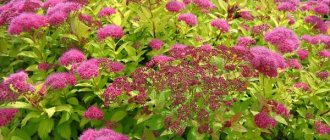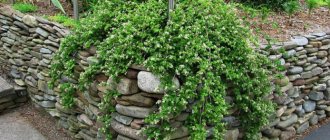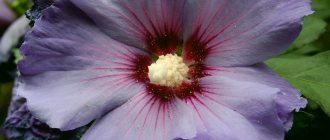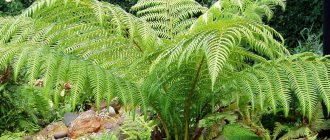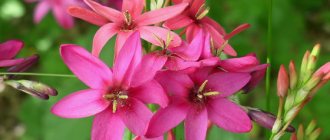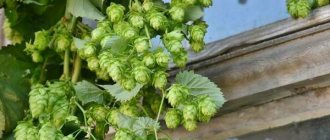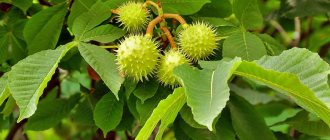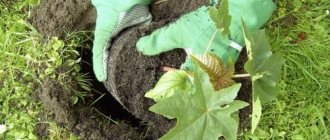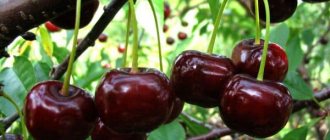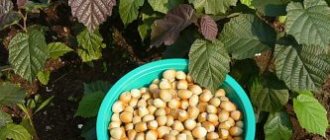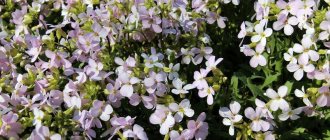Compact and snow-white Japanese spirea Albiflora
The beautiful spirea is used with pleasure for landscaping not only public parks, but also private properties. Spreading bushes, quite tall or, on the contrary, quite compact in size, also blooming profusely and beautifully, and unpretentious - isn’t this the dream of every gardener? A variety of spirea called Albiflora is especially loved: unlike most species, the buds of which are colored pink, Albiflora blooms with delicate white inflorescences and is modest in size.
What does the plant look like?
Japanese spirea Albiflora (as it is correctly called) belongs to the dwarf varieties of shrubs: the total height of an adult bush rarely exceeds 0.8 m, and even half-meter specimens are more common. The crown of the bush is spreading and lush, consisting of reddish branches and many elongated green leaves.
Even after flowering ends, Albiflora retains its decorative appearance thanks to the yellow-orange color of the leaves, which replaces the green color in early autumn.
Characteristic features of the variety include:
- abundant flowering (from the second half of summer until autumn the bushes are almost completely covered with white umbrellas of inflorescences emitting a delicate sweetish aroma);
- compact dimensions;
- no special requirements for soil composition;
- good frost resistance.
Spiraea Albiflora grows very slowly: the annual growth is a maximum of 10 cm.
Let's summarize
- Japanese spirea Albiflora is a perennial ornamental shrub that does not require care and tolerates Russian frosty winters well.
- This variety is a summer-flowering variety (with its white shield inflorescences it pleases owners from July to August, or even September). Although in autumn the shrub also looks beautiful thanks to its noble, golden foliage.
- You can plant the bush in a sunny or half-shaded area with light, well-drained soil. Once established, water it regularly, feed it occasionally, and don’t forget about annual spring pruning.
What other spirea exist? You can get acquainted with popular species and varieties in this video:
What is Japanese Spiraea?
This plant is an ornamental shrub that belongs to the Rosaceae family. The freely branching stems of the plant have simple leaves with slightly serrated edges, and the height of the bush can be from 1.2 m. Small spirea flowers are collected in large inflorescences, which are located throughout the bush. Their placement depends on the plant variety. In this case, shades can be from pale pink to rich crimson.
Spiraea bushes are compact in size and bloom profusely
In its natural environment, spirea grows in the Mediterranean climate, in Central Asia, Altai and the Caucasus. These regions have optimal conditions. Not all varieties can grow in central Russia, otherwise their growth is impaired, flowering becomes weak and short-lived.
Decorating the site with meadowsweet plantings
The shrub looks bright all year round, which is why it is very practical for garden design. There are no so-called gaps in the beauty of meadowsweet that would affect a specific season.
The roots of the plant do not entwine the root systems of nearby plantings, and the bush itself is not distinguished by a large number of root sprouts. This beauty gets along well with any environment .
Landscape designer's recommendation: a variety of Japanese spirea such as "Krisla" can be successfully used when creating a shrub-woody group , where its main purpose will be camouflage among tall-growing representatives of open trunks. These may include, for example:
- magnolia;
- lilac;
- mock orange
The compactness of the meadowsweet bush makes it possible to plant it also in flower beds with annuals and bulbous plants . They can even decorate a rose garden, in which low-growing perennials are also found.
Spiraea will be indispensable where you need to create a bright, unified image, for example:
- Dividing border.
- Hedge.
- When planting slopes.
This plant needs to be trimmed once a month , but the plant, of course, will not bloom. For this reason, before planting, it is recommended to decide in advance in what capacity this shrub will be considered: as an ornamental deciduous form or as an abundantly flowering one.
Meadowsweet can be trimmed perfectly; the bush is well developed and completely leafy. Some plants of the compact variety produce a wonderful golden hue of foliage, such as the Japanese spirea variety "Goldmound".
Anti-aging or sanitary pruning is carried out in such a way that the symmetry of the shoots is not disturbed. Only dead wood and broken branches are cut out. Bushes that are older than 4 years undergo more thorough pruning; several branches are removed from them down to the trunk .
Planting a plant
The plant is grown in fertile, loose and moist soil. This condition will ensure good growth of spirea of any variety, but it is equally important to choose the right young plant. Seedlings should be purchased only from specialized stores, garden centers or nurseries. Thanks to this, you can get a healthy plant of the desired variety.
Basic rules for selecting and preparing spirea seedlings:
- the root system of the purchased seedling must be closed, that is, with a lump of earth;
- the shoot should not have fully blossomed leaves, because such plants do not tolerate transplantation into the ground;
- The presence of several second-order branches on the shoot is appropriate. They should not be too spreading;
- a good seedling has light green bark, the buds should not be damaged;
- Before planting, long roots are shortened to 30 cm. If the root system is dry, then the seedling is first placed in water for a day.
If the seedling is in a pot, then it is important to make sure. that his capacity is not small
If you purchase a seedling in a pot, you need to inspect the openings of the container. When roots stick out of them, it means the container is too small for the plant and it has been there for a very long time. Such vegetation will take a long time and be difficult to take root in open ground.
Best regions for planting
Spiraea grows well in many regions. For example, all varieties are suitable for the Krasnodar Territory, the Caucasus and Asia, since the climate here is warm. For cultivation in the Urals, in the western and southern parts of Siberia, in central Russia, frost-resistant species are chosen. Gray spirea, Vanguta, Billarda, Firelight and others that tolerate frost down to -25 °C are suitable for these areas.
Planting stages
After selecting high-quality seedlings of the optimal variety for the region, planting is carried out. The main rules and main stages of this process, carried out in the fall, are expressed as follows:
- prepare holes with a depth of 40 cm. A layer of sand or small crushed stone about 10 cm thick is laid on the bottom. If several bushes are planted in a row, then the minimum distance between the holes should be 35 - 40 cm;
The hole must have a drainage layer
No need to add fertilizers to water for irrigation
It is best to plant seedlings not in a freshly dug hole, but in a hole created 2–3 days before transplanting the plant. During this time, the soil will be ventilated and the bush will be comfortable. If the soil is clayey, then crushed stone and sand are added to it in layers of 20 cm. Before planting, the soil that is too dry and hard is slightly moistened, but it is best to plant the plant in cloudy and rainy weather. It is worth remembering that summer-flowering varieties are planted in the ground in the spring until the buds open. If the plant is a spring flowering plant, then this process is carried out in the fall. Bushes can be grown in one place for about 15 years.
Planting Japanese spirea
The site for this Japanese spirea can be chosen either in partial shade or in the sun. It is good if the soil is moderately moist. That is, spirea can be planted in lowlands.
The soil can also be anything. But it will be better if the soil is fertile and airy (loam, sandstone, in which water does not stagnate). In such soil the shrub blooms more generously. If the soil in the flowerbed is too “tight”, you can help the flower by forming a drainage “cushion” when planting, that is, laying a layer of broken brick, slate or large stones at the bottom of the hole.
Time . Albiflora is planted in the fall, even before the end of leaf fall.
Planting a plant step by step
- Carefully inspect the seedling in the store or nursery. Discard specimens with broken branches or cut roots immediately.
- 2 weeks before planting, dig up the garden soil, adding organic fertilizer to it.
- Before planting, inspect the root system again. If you feel that some of the roots are sticking out too much from the general mass, you can cut them off. It is correct to do this with the sharpest possible tool, and to prevent rot from penetrating into the cut, rub it with crushed charcoal. It also wouldn’t hurt to treat the roots with Kornevin or another similar preparation.
- You can also trim the branches of the bush (but to a maximum of 25% of their length).
- If the seedling was purchased in a container, water it well - this way the plant can be removed with the least amount of trauma.
- Having assessed the size of the roots, dig a hole so that the root system fits freely into it. For a bush of this type, you need a hole about half a meter deep and wide. Let me remind you - if the soil is “tight”, lay drainage at the bottom. If you have done this, pour a little soil onto the drainage and place the seedling on top of it.
- In the hole, it is better to sprinkle the seedling not just with excavated soil, but with a prepared mixture consisting of “native” garden soil, sand (adds airiness) and peat (airiness + nutrition). If the original soil seems rather poor to you, give a gram of complex mineral fertilizer for each kilogram of soil mixture.
- Deepen the root collar, but slightly - a maximum of 1 cm.
- At the end, water the bush well. It is also advisable to immediately mulch the tree trunk circle. You can use wood chips or sawdust, small tree bark, or dry grass.
What care needs to be provided
After planting the seedling in open ground, a multi-stage process of caring for the plant begins. One of the main actions is watering, which is carried out 2 – 3 times per season. If the summer is dry and hot, then you can increase the frequency of irrigation of the bush. For irrigation use ordinary clean water.
Young seedlings need protection during the winter. To do this, you need to cover the soil near the trunk with foliage and geotextiles, and tie the thin trunk to a peg installed nearby.
In summer, the plant is fed. Mullein diluted in 10 liters of water and 10 g of superphosphate are sufficient for this purpose. You can use Kemira universal and other components in the second year of bush growth.
With proper care, young bushes bloom very quickly
Pruning is one of the main stages of plant care, allowing you to give the bush the desired shape. In spring-flowering varieties, after flowering ends, dry shoots and old branches are removed with sharp garden scissors.
Bushes are pruned regularly, but carefully
Summer-flowering bushes are pruned from the fourth year after planting. They make a radical haircut, removing the old lower and upper shoots. If you remove only the tops, then the new shoots will be thin and with small inflorescences. It is important to remember that in the first years you cannot prune the bushes too much. Only dry, damaged branches are removed.
Solving possible problems when growing Japanese spirea
Most varieties of Japanese spirea are unpretentious and do not require special care. If problems arise during cultivation, then you should pay attention to the conditions in which the bush grows.
Spiraea in the process of growth and flowering is susceptible to the following problems:
- Infestation by aphids, rose leaf miner, and leaf roller is possible from mid to late summer. In such cases, an inspection is carried out, the affected areas are identified and the plant is sprayed with solutions such as pirimor - 0.1%, kronefos - 0.3%, ethafos - 0.2%, hostaquik - 0.1%;
- Keltan, fozalon, metaphos, phosphamide, acrex are used to combat spider mites. It is best to start processing before three mites appear;
- If at the height of the season the branches and leaves begin to dry, then you need to make sure there is sufficient watering and the quality of the soil. If necessary, fertilize and water the plant.
These problems are the main ones, and it is possible to prevent pests by regularly irrigating the bushes.
Plant propagation methods
If propagation of Japanese spirea bushes is required, then different methods are used for this. In each case, it is important to use high-quality basic planting material, as well as prepare the soil on the site and in the pots.
Planting and caring for the plant
Spiraea japonica is a shrub that is very popular among designers, including landscape designers, and it has gained such popularity due to its decorative properties: they persist from the first days of spring until frost. The cost of planting material is low, and it can be purchased in literally every nursery.
Despite all the luxury during the flowering period, Spiraea japonica is easy to care for and plant . The peculiarity of this plant is its excellent adaptability to conditions and climate, because it is very hardy and can adapt without much effort to any natural conditions, soil quality, etc.
On the territory of our state, meadowsweet, which is exactly what its second name sounds like, is grown literally everywhere, from the South coast to cold and dry areas. However, there are several varieties that can freeze in severe winter conditions. To protect them, it will be necessary to carry out spring pruning . It is needed for sanitary purposes. After this event, the bush will be able to recover and present abundant flowering in the same year.
Spiraea (meadowsweet) only needs 3-4 hours of direct sunlight during the day, and then with this minimum the owner of the plant will have the opportunity to admire not only its lush growth, but also its abundant flowering. With regular sunlight, the bush will accordingly be even richer.
Agrotechnical features of cultivation
The conditions usually necessary for other plants, such as: a method of shelter in winter, are not very important for spirea; irrigation intensity; soil fertility. Watering meadowsweet is required only during the first year after planting in the soil.
There are no special recommendations for pruning, but under skillful hands the crown of the plant is perfectly formed. The shrub can grow from 30 cm to 1.5 meters .
This indicator depends on what specific variety was planted. The shape of its crown in some cases is thickened and dense, in others it is disheveled and sparse. But basically it can be described as spherical. The foliage is very good, the trunks do not show through even close to the ground.
Description of Japanese spirea Albiflora
It is a small deciduous shrub, about 80 cm in height. The diameter of the bush is on average 1.5 m, the crown is spreading and dense. Young shoots of this variety are slightly pubescent.
Japanese spirea Albiflora grows slowly. The annual growth is only 10 cm.
The shape of the leaves is elongated, ovoid. The edges are slightly jagged. The length of the leaf blade reaches 7 cm. The foliage is painted in delicate green tones, however, in September the leaves turn yellow and gradually acquire a bright orange color.
The description indicates that the flowers of the Japanese spirea variety Albiflora are small, as can be seen in the photo below, and they are collected in dense corymbose inflorescences, the diameter of which does not exceed 6-7 cm. The color of the petals is white.
One of the leading characteristics of the variety is its abundant flowering, which lasts from July to August.
Description of the Japanese spirea “Albiflora” - Spiraea japonica “Albiflora”
Height, overall dimensions and growth:
One of the few varieties of summer-blooming spireas with white flowers. Dwarf deciduous shrub, reaches up to 0.8 m in height and up to 1.5 m in diameter. Slow growing variety, annual growth 5-10 cm.
Decorativeness/flowering:
Blooms continuously from July to September. The flowers are white, small, collected in corymbose inflorescences with a diameter of 7 cm. Blooms profusely in July-August.
Frost resistance, maintenance conditions:
Winter hardiness zone – 4. Most species and varieties of spirea easily tolerate winter in the middle zone without shelter.
Usage:
Prefers fertile and loose soil. For longer flowering, it is recommended to trim off faded inflorescences.
Photos of Japanese spirea Albiflora.
Spiraea Albiflora in landscape design
Japanese spirea Albiflora variety is highly valued in landscape design for its resistance to air pollution, which allows the shrub to be used as a decoration for city parks, medical institutions and playgrounds. Plants are planted both individually and as part of group flower arrangements: rock gardens, borders, flower beds.
This variety can also be used as a ground cover crop for decorating slopes. In addition, Japanese spirea Albiflora is often included in multi-layer compositions, where the shrub is combined with trees and shrubs weaving along supports.
The photo below shows a homogeneous composition of Japanese spirea bushes of the Albiflora variety.
Application in landscape design
This plant appears in the garden solely as a decoration. With its help, it is possible to create lush, but at the same time bright and lacy hedges, as well as compositions with other shrubs and flowers. Depending on the appearance, the shrub is used in a general composition or separately.
We invite you to familiarize yourself with what spirea is combined with in landscape design.
The shape of such a plant can be:
- Creeping, which is actively used alone.
- Hemispherical, most attractive with other shrubs.
- Erect, used to create hedges.
Having studied the above information, we can conclude that spirea is an unpretentious plant and does not require special care. In addition, there is no need for abundant fertilization of the roots and watering. Frequent soil moistening is required only during dry seasons. Also, a big advantage of this type is its ability to maintain its shape all year round, which eliminates unnecessary effort in forming the crown.
Planting and caring for Japanese spirea Albiflora
This variety is not capricious and grows well both in open sunny areas and in partial shade. The shrub does not have any special requirements for the composition of the soil; however, when planted in loose, fertile soils, the flowering of spirea will be more abundant.
Plant care includes the most basic procedures: sanitary and formative pruning, watering and fertilizing. The shrub is one of the most frost-resistant varieties, so adult plants do not need shelter for the winter. Spiraea Albiflora does not tolerate drought well, so it is important to ensure that the soil in the plant’s tree trunk does not dry out.
Preparation of planting material and site
Before planting the plant in a permanent place, it is necessary to carefully inspect the planting material for mechanical damage. There should be no breaks or cuts on the seedlings - through these damages the spirea can be infected with a fungus.
In addition, it is recommended to lightly trim the roots of the plant if some of them stand out from the total mass. You can only use a sharp tool for this. When cutting with dull scissors or a knife, there is a high risk that creases will remain at the cut site. This greatly affects the survival rate of the plant in open ground.
If desired, you can also shorten the shoots of the seedling in order to adjust its shape, but pruning should be moderate. Branches are pruned only by 20-25%, no more.
Before planting spirea, the garden plot should be carefully dug up 10-15 days before. At the same time, organic fertilizers are added to the soil in moderate quantities.
Planting Japanese spirea Albiflora
The Albiflora variety is planted in the fall, before leaf fall ends. The landing algorithm looks like this:
- Before planting in open ground, planting material is watered abundantly if it was previously in containers.
- The recommended dimensions of the planting hole are 40-50 cm in depth and 50 cm in diameter. In many respects, you should focus on the size of the root system of the seedling - the roots should be freely located in the hole.
- If the soil in the area is heavy and clayey, a drainage layer of broken bricks, small stones or fragments of clay shards is placed at the bottom of the pit.
- After this, the hole is filled with soil mixture, which is usually prepared independently. To do this, you need to mix peat, fine-grained sand and topsoil from the site in equal proportions.
- For better growth of spirea, you can add complex fertilizer to the pit (about 5 g per 1 kg of mixture).
- The seedling is carefully lowered into the hole and the roots of the plant are straightened.
- The hole is filled with earth and the tree trunk circle is lightly compacted.
- Planting is completed with abundant watering, loosening the soil near the plant and mulching. This is done so that the soil retains moisture better after rains and waterings. Sawdust, dry grass, tree bark or wood chips can be used as mulch.
You can learn more about the peculiarities of planting the Japanese spirea variety Albiflora from the video below:
Watering and fertilizing
Japanese Spiraea Albiflora responds well to regular watering. This is especially true for young plants, since their roots have not yet developed sufficiently and are not able to provide the bush with the necessary amount of moisture from the lower layers of the soil. An adult spirea is watered about once a week.
Caring for Albiflora
Watering . A must, especially in the hot summer. The fact is that drought is the only thing that can kill this spirea. So always make sure that the soil in the tree trunk circle of the bush is always slightly moistened (but of course, without going overboard - the plant will not happily turn green in a permanent swamp either).
An adult bush can be watered once a week, and a young, recently planted bush can be watered more often.
Feeding . In spring, Albiflora needs nitrogen fertilizer, because until summer the bush simply grows branches and leaves. Although a complex “mineral water” created for garden crops is also suitable.
In the fall, during preparation for wintering, pamper the bush with fertilizing with potassium and phosphorus. Firstly, it will help the plant recover faster after flowering. Secondly, it will strengthen the roots, which is very important for withstanding frost.
Preparing for winter . Since Albiflora is one of the most frost-resistant varieties (withstands temperatures dropping to -30 degrees and even lower), there is no need to cover the bush for the winter in the middle zone.
However, young bushes that have not yet had time to take root well can be secured by first covering them with 20 cm of soil, then mulching them with compost or peat, and finally bending them to the ground (burlap can be placed under the branches) and, fixing them with staples, insulating them with spunbond and other non-woven material.
Trimming
This culture needs two types of haircuts: shaping and sanitary .
The nursery recommended that I trim the bush annually, in early spring . Remove diseased, broken and dry (this is what frozen branches look like) branches. Also, about a quarter of last year's shoots need to be removed from the bush. Thanks to this, it will grow new shoots, and therefore bloom more.
True, I also heard the opinion that spirea can be cut in the fall . You will see a correct example of such pruning (although not the Albiflora variety, but similar) here:
Let me add from myself: autumn pruning can be carried out in warm countries or regions (in Ukraine or Moldova, in the south of Russia). Winters here are not as early and harsh as in central Russia, so the bush will have time to recover from pruning and prepare for the winter. But in most Russian regions, as well as in Belarus, I would recommend disturbing Albiflora by pruning in the spring.
Important point! After pruning (no matter what time of year you do it), it is advisable to feed the bush. First, water the spirea with a solution of manure. After this, feed it with superphosphate (taking 8 g of this substance per 10 liters of water).
Is this plant sick?
Traditional diseases of garden bushes almost do not affect Albiflora. Unfortunately, the same cannot be said about pests.
aphids, spider mites, and roseate leaf rollers like to parasitize this shrub . You shouldn’t turn a blind eye to these small “predators”. As soon as you see them or traces of insect activity (cobwebs, light spots on the leaves of a bush, leaves falling or curled up for no reason), buy an insecticide and treat the plant heartily.
Don’t want purchased poison to get onto your property? To begin with, you can treat the spirea with a solution of soap (laundry soap) or ash. In the latter case, you will also receive nutrition for the plant, since ash is a valuable source of nitrogen.
Reproduction
Japanese spirea of the Albiflora variety can be propagated either vegetatively or by seeds, but the first method is still preferable. Seed propagation requires a lot of time.
Vegetative methods include cuttings and layering.
The cuttings are prepared according to the following scheme:
- On the bush, semi-lignified branches of the current year are selected and cut closer to the ground.
- The resulting cut is further divided, resulting in cuttings about 10 cm long each. For propagation, you can use both the outer cuttings and the inner part of the shoot.
- The bottom of the cuttings is cleared of leaves.
- The lower cut is treated with a root growth stimulator, after which the cuttings are planted in containers.
After a year, the spirea can be transplanted to a permanent place.
Reproduction by layering is considered one of the easiest ways to propagate Albiflora spirea:
- Before the leaves bloom, the side branch of the bush is bent and fixed in the ground.
- During the season, the cuttings are watered regularly.
- In the fall, the branch is finally separated from the mother bush and replanted.
Decorative varieties of spirea
Japanese spirea has its own decorative varieties, and those, in turn, have their own characteristics and disadvantages.
This beautiful shrub can be described as follows: it has felt-pubescent shoots, succulent oblong leaves, bluish below and green at the top, which are colored in autumn with all sorts of shades of red-orange tones.
Flowering lasts up to fifty days a year. This type of meadowsweet has many varieties, which differ in the intensity of flowering and color , shape and height of the crown. It is believed that the following varieties are most common in our country.
Little Princess
Spiraea Japanese Little Princess is capable of forming a neat bush up to 60 cm high, with a compact rounded crown, blue-green leaves growing in the shape of an elongated ellipse.
Little Princess has pink flowers , which are collected in a scale inflorescence. The flowering period occurs in early or mid-summer. The shrub grows slowly.
It looks inimitable both in single plantings and in creating shrub groups , landscaping at the edges, and in hedges. Among the disadvantages of this variety of meadowsweet, one can note only the rapid loss of color saturation, which can fade in open sunlight.
Japanese Dwarf
Japanese Dwarf is another plant variety. Perfect for an alpine hill, to participate in any garden composition. It reaches a height of up to 30 cm. The crown shape is round. The plant produces thin shoots with small green leaves.
In July, the flowering period begins, and lilac flowers , which are collected in corymbose inflorescences. Flowering occurs so magnificently that it completely hides the leaves. The flowering period is long and lasts for 2 months.
Shirobana variety
Japanese spirea variety Shirobana is a shrub that grows up to 80 cm. It has dark green narrow lanceolate leaves reaching a length of about 2.5 cm.
Shirobana's flowers can be bright pink or white , and sometimes red.
It all depends on the amount of light falling on the place where the bush grows. Flowering begins in July, then the plant produces new flower stalks abundantly until mid-August. “Shirobana” can diversify such landscape decor compositions as:
- Low curbs.
- Compositions of conifers.
- Rock gardens and other shrubs.
The main disadvantage of the Shirobana variety is the untidiness of the bush. But it can be easily adjusted . And without pruning, meadowsweet forms a “chaotic” crown.
Spiraea Albiflora
Japanese spirea Albiflora (also known as white spirea Albiflora japonica) is a bush 60 cm tall, its flowers are snow-white, which is extremely unusual for spireas, the flowering period of which begins in the summer.
In this phase, an indescribable, rich and thick aroma . The foliage of the plant is oval-shaped, green, and against its background the snow-white inflorescences look especially stunning. However, as the flowers fade, they begin to acquire a brownish-withered hue, so such flower stalks should be removed in a timely manner.
Golden Princess
Japanese Spiraea Golden Princess is an interesting shrub that reaches a height of 55-60 cm, the spread and diameter of the crown is 1 m or slightly higher. In spring, the foliage takes on a bright yellow hue.
In summer it brightens, and in September the leaves turn orange with soft undertones. Its leaves are 7-8 cm long. Flowering occurs in June and is very abundant. themselves are red-pink and pink , which are collected in a scale inflorescence.
It can reach up to 5 cm in diameter. Golden Princess attracts insects, for this reason it is not recommended to be planted in children's recreation areas and for walks.
Groundcover spirea is often used as a decorative element , which gets along well with other low-growing plants, such as St. John's wort, lavender, rudbeckia, cinquefoil, yarrow, and field herbs. In recent years, many varieties of this shrub can be found not only in private plantings, but also in city parks.
Diseases and pests
Japanese spirea Albiflora practically does not get sick, but occasionally pests can affect plantings. These include:
- spider mite;
- rose leaf roller;
- aphids
Among these insects, the most dangerous is the tick. The appearance of the pest is indicated by whitish spots on the leaves and thin cobwebs. If nothing is done, the spirea leaves will begin to turn yellow and crumble, and small holes will appear in the inflorescences.
In order to get rid of the tick, it is necessary to treat the bushes with insecticides. Preparations such as “Phosfamide” and “Karbofos” effectively control the pest.
In mid-summer, bushes can attract aphids, which nibble on the inflorescences and suck the juice from them. The drug “Pyrimor” is used against this pest, which also works well against leaf rollers.
Traditional methods of fighting insects include treating spirea with a solution of ash or laundry soap.
Spiraea japonica Albiflora
Probably everyone has noticed at least once in the summer in parks and squares lush, large, rounded bushes, densely strewn with clusters of white flowers with a delightful honey aroma. This is a blooming spirea - one of the most popular perennial shrubs in the European part.
Lush-flowering perennial ornamental shrubs have been used for many years for landscaping parks and squares, creating landscape ensembles, decorating borders and garden fences, and creating garden labyrinths. These plants are remarkable for their decorative qualities, ease of care, frost resistance and resistance to sudden changes in weather. They are distinguished by a wide variety of species and excellent decorative qualities. Tall, human-sized, and short - spirea is an excellent choice for decorating the lawn and achieving the necessary color accents in the garden.
Decorative qualities of Japanese spirea albiflora
Despite the fact that all spirea are equally popular when decorating suburban areas and lawns, gardeners still have their own favorites. And among them is the Japanese albiflora spirea (spiraea jap albiflora). This popularity is explained primarily by the fact that the shrub retains its decorative properties from early spring to late autumn.
This variety of spirea blooms profusely with white flowers all summer, unlike many of its relatives, which delight the eye with a lash of red-pink flowers. Spiraea albiflota bushes are low, about 50-80 centimeters in height, with yellowish-red-brown stems and leaves, green above and bluish-green below.
Gardeners love this variety of spirea for the ability to grow it in combination with other, taller shrubs, such as lilac, as well as for the ability to create multi-layered compositions with its help, combining albiflora with bushes, trees and plants climbing along a wall or fence.
Spiraea albiflora tolerates pruning well, which makes it possible to create interesting decorative forms.
From the history of the species
The name of the shrub comes from the Greek word "speira", which means spiral or bend. Almost all known species of spirea have long flexible branches that bend beautifully, bending towards the ground. There is another popular name for spirea - meadowsweet. Although many botanists dispute the relationship of these plants, since all types of spirea are shrubs, and meadowsweet is more likely to be a herbaceous species.
The beauty and versatility of spirea has been appreciated quite a long time ago. In the 16th century, the cultivation of willow spirea began. Two hundred years later, middle and oak-leaved spireas appeared in cultivation. And in the 19th century, birch leaf spirea was bred.
The genus Spiraea has about ninety species. Some types of spirea are often in demand by gardeners, others selectively and rarely. However, almost all species, due to their tenderness, decorativeness, long flowering time, resistance to cold and heat and the ability to survive in an urban environment, deserve great attention from landscape designers and simply amateur gardeners.
